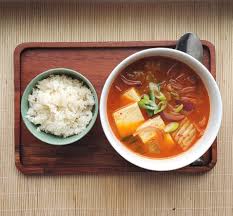A Flavorful Journey to Korea: Kimchi Jjigae
The bubbling pot of Kimchi Jjigae not only warms the soul but also tantalizes the taste buds with its rich, spicy tang. For those on a culinary adventure, South Korea’s signature stew is an essential stop. To the uninitiated, it may seem like just another hot pot, but for foodies in the know, it’s a symphony of flavors with each ingredient playing a vital note. In this exploration, we’ll uncover the essence of Kimchi Jjigae, from what gives it that unmistakable depth to a simple yet heartwarming recipe for you to try in your own kitchen.
What is Kimchi Jjigae?
Transitioning from mere side dish to the shining star of a meal, Kimchi Jjigae is a staple of Korean cuisine. Literally translated as “kimchi stew,” it represents the quintessential taste of Korea, with an umami punch that leaves a lasting impression.
The Taste of Tradition
Imagine a pot brimming with intensely flavored kimchi, tender chunks of meat (often pork), tofu adding a silky softness, and the zing of gochugaru (Korean red pepper flakes), all harmonizing to create a dish that’s simultaneously spicy, sour, and savory. This complexity of flavor is what makes Kimchi Jjigae stand out.
The Essential Ingredients
Kimchi Jjigae starts with the most basic element of Korean cooking – kimchi. It’s homemade or store-bought but always fermented. The sourness and depth of flavor in the kimchi are what give this stew its soul. Add to it some protein, like pork belly or tuna, and a splash of soy sauce for that rich, salty undercurrent. Tofu softens the stew and adds a subtle creaminess, while scallions, garlic, and ginger contribute their aromatic fervor.
The Science of Spiciness
If there’s one thing that’s universal about Kimchi Jjigae, it’s heat. The prominence of red pepper in Korean cuisine reflects not just a love for spice, but a belief in the health benefits of this essential ingredient. Gochugaru enlivens the stew, infusing it with a gentle heat that lingers on the palate, inviting you to savor each spoonful.
Nutritional Virtues of Korean Spice
Beyond its punch, gochugaru supplies a dose of capsaicin, known for metabolic enhancement. It also boasts a cache of antioxidants. For those wary of its intensity, rest assured – the warm, toasty notes of gochugaru are as addictive as they are beneficial.
Crafting Kimchi Jjigae in Your Kitchen
Now that you’re acquainted with the allure of Kimchi Jjigae, wouldn’t it be delightful to prepare it at home? Here’s a recipe that demystifies the process, allowing you to bring a piece of Korea to your dinner table. Remember, the soul of Korean cooking is in the imperfections that come from your personal touch – don’t be afraid to experiment and make it your own.
Recipe for Kimchi Jjigae
Ingredients
- 2 cups of well-fermented kimchi
- 1/2 pound of sliced pork belly or shoulder
- 2 cups of kimchi broth or water
- 2 tbsp of gochugaru (Korean red pepper flakes)
- 1 tbsp of gochujang (Korean red pepper paste)
- 1 onion, sliced
- 3 green onions, cut into 2-inch lengths
- 5 cloves garlic, minced
- 1/2 inch ginger, peeled and minced
- 1/2 pound of tofu, cut into cubes
- 1 tsp of soy sauce
- 1 tsp of sugar
- 1 tbsp of sesame oil
- Salt, to taste
- 1 tbsp of vegetable oil
Instructions
- Start by soaking the sliced pork in cold water to remove some of the blood. Drain and set aside.
- In a heavy-bottomed pot, heat the vegetable oil over medium heat. Add onion, green onion whites, garlic, and ginger. Sauté until fragrant.
- Add the pork and cook until it turns white, stirring frequently.
- Reduce the heat to low. Add the kimchi, gochugaru, and gochujang. Stir well to combine.
- Pour in the kimchi broth or water and increase the heat to bring the stew to a boil.
- Once boiling, reduce the heat to medium-low and simmer, covered, until the pork is tender, about 30 minutes.
- Add the tofu, soy sauce, and sugar. Simmer for an additional 10 minutes.
- Stir in the green onion greens and sesame oil. Season with salt if needed.
- Serve hot with a bowl of rice and enjoy the spicy, soul-warming taste of Korea.
Notes on Taste and Texture
The quality of kimchi plays a crucial role in the final taste. Look for well-fermented kimchi that is tangy and pungent. The addition of sugar helps to balance the sourness.
For a vegan or vegetarian version, simply omit the meat and use vegetable broth or water instead of kimchi broth.
Final Thoughts
Kimchi Jjigae is more than a comfort food; it’s a cultural experience brimming with tradition and taste. As you savor each spoonful, allow it to transport you to the busy streets of Seoul or the tranquil temples on the outskirts, where this timeless stew is served with pride. And if you’re eager for further culinary escapades, the world of Korean cuisine offers a treasure trove of delights waiting to be explored.
In conclusion, whether whipped up in your kitchen or sampled in a Korean eatery, Kimchi Jjigae promises a spicy, savory indulgence – a testament to the magical alchemy that happens when humble ingredients are combined with care. Happy cooking, and may your Kimchi Jjigae be as delightful to eat as it was to prepare.
